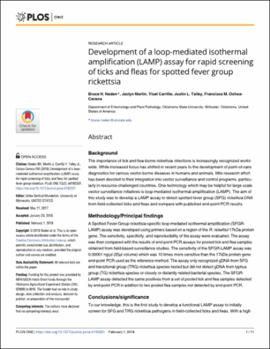| dc.contributor.author | Noden, Bruce H. | |
| dc.contributor.author | Martin, Jaclyn | |
| dc.contributor.author | Carrillo, Yisel | |
| dc.contributor.author | Talley, Justin L. | |
| dc.contributor.author | Ochoa-Corona, Francisco M. | |
| dc.date.accessioned | 2022-04-12T13:45:04Z | |
| dc.date.available | 2022-04-12T13:45:24Z | |
| dc.date.issued | 2018-02-01 | |
| dc.identifier | oksd_noden_developmentofaloopmediated_2018 | |
| dc.identifier.citation | Noden, B. H., Martin, J., Carrillo, Y., Talley, J. L., & Ochoa-Corona, F. M. (2018). Development of a loop-mediated isothermal amplification (LAMP) assay for rapid screening of ticks and fleas for spotted fever group rickettsia. PLoS ONE, 13(2), Article e0192331. https://doi.org/10.1371/journal.pone.0192331 | |
| dc.identifier.uri | https://hdl.handle.net/11244/335146 | |
| dc.description.abstract | Background: The importance of tick and flea-borne rickettsia infections is increasingly recognized worldwide. While increased focus has shifted in recent years to the development of point-of-care diagnostics for various vector-borne diseases in humans and animals, little research effort has been devoted to their integration into vector surveillance and control programs, particularly in resource-challenged countries. One technology which may be helpful for large scale vector surveillance initiatives is loop-mediated isothermal amplification (LAMP). The aim of this study was to develop a LAMP assay to detect spotted fever group (SFG) rickettsia DNA from field-collected ticks and fleas and compare with published end-point PCR results. | |
| dc.description.abstract | Methodology/Principal findings: A Spotted Fever Group rickettsia-specific loop-mediated isothermal amplification (SFGR-LAMP) assay was developed using primers based on a region of the R. rickettsii 17kDa protein gene. The sensitivity, specificity, and reproducibility of the assay were evaluated. The assay was then compared with the results of end-point PCR assays for pooled tick and flea samples obtained from field-based surveillance studies. The sensitivity of the SFGR-LAMP assay was 0.00001 ng/ul (25ul volume) which was 10 times more sensitive than the 17kDa protein gene end-point PCR used as the reference method. The assay only recognized gDNA from SFG and transitional group (TRG) rickettsia species tested but did not detect gDNA from typhus group (TG) rickettsia species or closely or distantly related bacterial species. The SFGR-LAMP assay detected the same positives from a set of pooled tick and flea samples detected by end-point PCR in addition to two pooled flea samples not detected by end-point PCR. | |
| dc.description.abstract | Conclusions/significance: To our knowledge, this is the first study to develop a functional LAMP assay to initially screen for SFG and TRG rickettsia pathogens in field-collected ticks and fleas. With a high sensitivity and specificity, the results indicate the potential use as a field-based surveillance tool for tick and flea-borne rickettsial pathogens in resource-challenged countries. | |
| dc.format | application/pdf | |
| dc.language | en_US | |
| dc.publisher | Public Library of Science (PLoS) | |
| dc.relation.ispartof | PLoS ONE, 13 (2) | |
| dc.relation.uri | https://www.ncbi.nlm.nih.gov/pubmed/29390021 | |
| dc.rights | This material has been previously published. In the Oklahoma State University Library's institutional repository this version is made available through the open access principles and the terms of agreement/consent between the author(s) and the publisher. The permission policy on the use, reproduction or distribution of the material falls under fair use for educational, scholarship, and research purposes. Contact Digital Resources and Discovery Services at lib-dls@okstate.edu or 405-744-9161 for further information. | |
| dc.subject.mesh | Animals | |
| dc.subject.mesh | Limit of Detection | |
| dc.subject.mesh | Nucleic Acid Amplification Techniques | |
| dc.subject.mesh | Rickettsia | |
| dc.subject.mesh | Siphonaptera | |
| dc.subject.mesh | Ticks | |
| dc.title | Development of a loop-mediated isothermal amplification (LAMP) assay for rapid screening of ticks and fleas for spotted fever group rickettsia | |
| dc.date.updated | 2022-04-07T14:15:57Z | |
| osu.filename | oksd_noden_developmentofaloopmediated_2018.pdf | |
| dc.description.peerreview | Peer reviewed | |
| dc.identifier.doi | 10.1371/journal.pone.0192331 | |
| dc.description.department | Entomology and Plant Pathology | |
| dc.type.genre | Article | |
| dc.type.material | Text | |
| dc.subject.keywords | Rare Diseases | |
| dc.subject.keywords | Infectious Diseases | |
| dc.subject.keywords | Prevention | |
| dc.subject.keywords | Orphan Drug | |
| dc.subject.keywords | Vector-Borne Diseases | |
| dc.subject.keywords | Emerging Infectious Diseases | |
| dc.subject.keywords | Biotechnology | |
| dc.subject.keywords | Genetics | |
| dc.subject.keywords | Biodefense | |
| dc.subject.keywords | Vaccine Related | |
| dc.subject.keywords | Infection | |
| dc.subject.keywords | General Science & Technology | |
| dc.rights.license | https://creativecommons.org/licenses/by/4.0/ | |
| dc.identifier.author | ORCID: 0000-0002-0096-370X (Noden, BH) | |
| dc.identifier.author | ScopusID: 6601968347 (Noden, BH) | |
| dc.identifier.author | ScopusID: 56585001500 (Martin, J) | |
| dc.identifier.author | ScopusID: 57200440974 (Carrillo, Y) | |
| dc.identifier.author | ORCID: 0000-0002-2932-1866 (Talley, JL) | |
| dc.identifier.author | ScopusID: 55168292000 (Talley, JL) | |
| dc.identifier.author | ScopusID: 8878645100 (Ochoa-Corona, FM) | |
